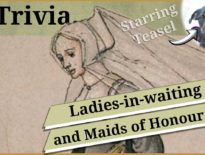Lucy Somerset was born in around 1524 to Henry Somerset, 2nd Earl of Worcester, and his second wife, Elizabeth Browne, who is perhaps best known for her alleged role in Anne Boleyn's downfall. Little is known of Lucy's early life; however, as a noblewoman, it is assumed that she would have been accomplished in courtly manners. She was also involved with prominent courtiers, particularly the Brandon family through her aunt's marriage to Sir Charles Brandon, Duke of Suffolk. This made Lady Anne Brandon and her sister Lady Mary Brandon her first cousins and important connections, both with prominent royal relations and friendships.
It is believed that Lucy was sent to the court of Henry VIII around 1540 aged 16, where she served his fifth consort, Katherine Howard, as a Maid of Honour during her marriage to Henry VIII. In 1542, when Katherine Howard was awaiting execution for treason, Lucy was supposedly mentioned in a letter by the imperial ambassador, Eustace Chapuys. This letter contains gossip from Chapuys who tells Charles V about the women Henry VIII is showing favour to, perhaps looking for his sixth wife. However, this information is not confirmed, and the only letter I have seen which potentially references this event does not mention Lucy. (See the end of the article for a link to the letter).
In 1543, Henry chose Katherine Parr to be his sixth wife, and in 1545, Lucy married Katherine Parr's stepson, John Neville, 4th Baron Latimer. This marriage made Lucy the new Baroness Latimer and also, perhaps due to a fondness for her stepson, Katherine invited Lucy to become a lady-in-waiting. This invitation resulted in Lucy becoming part of a very exclusive group surrounding the queen. Little is recorded of Lucy following this, and we don't know how she was affected by the death of Katherine Parr.
Lucy's marriage to her husband continued even though he became emotionally unstable in his later years. The couple managed to have four daughters together, all of whom would become co-heiresses to Latimer's estate and Barony. All of Lucy's daughters secured good marriages but especially her two eldest, with Katherine Neville marrying Henry Percy, 8th Earl of Northumberland, and Dorothy Neville marrying the 1st Earl of Exeter. Lucy Neville married Sir William Cornwallis of Brome Hall, and Elizabeth Neville married Sir John Danvers and later Sir Edmund Carey, Mary Boleyn's grandson.
In 1577, John Neville died, and, after years of trouble with the law, his four daughters became joint heiresses. Lucy herself died a few years later, in 1583, and was buried in Hackney.
by Georgia Whitehead
Georgia has just finished her masters in Classics at the University of Edinburgh. Academically, Georgia is interested in early Christianity, with her master's thesis focusing on "The Male Gaze and Self-Representation in Female Christian Narratives". In addition to her interest in ancient history, she has always been an avid lover of the Tudor era, drawn to the magnificence of the Tudor courts and the larger than life characters. She is particularly interested in The Reformation, Christianity and the shifting sands of ecclesiastical politics in this period and also has a keen interest in the lives of Tudor women. It is Georgia's ambition to become a writer, perhaps publishing her own Tudor novel one day.
Georgia also runs a history blog and instagram page called .
Sources
- James, Susan E. (2009). Catherine Parr, Henry VIII's Last Love.
- Richardson, Douglas (2011). Magna Carta Ancestry: A Study in Colonial and Medieval Families, ed. Kimball G. Everingham.
- Letter from Chapuys to Charles V that supposedly mentions Lucy. I found no mention of her name.
https://www.british-history.ac.uk/letters-papers-hen8/vol17/pp713-743#highlight-first



Leave a Reply